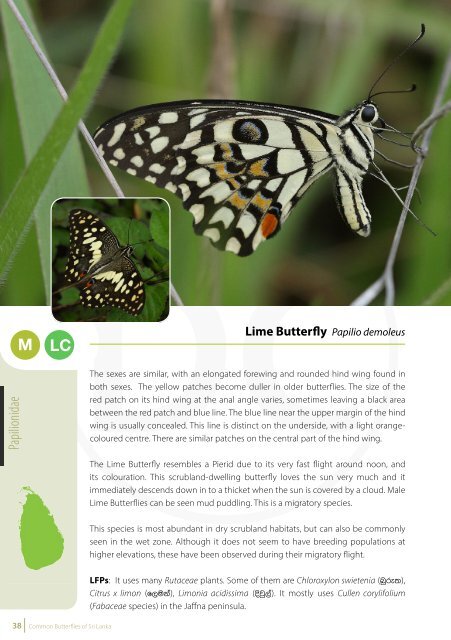Common Butterflies of Sri Lanka
Common Butterflies of Sri Lanka
Common Butterflies of Sri Lanka
Create successful ePaper yourself
Turn your PDF publications into a flip-book with our unique Google optimized e-Paper software.
Lime Butterfly Papilio demoleus<br />
Red Helen Papilio helenus<br />
M LC L VU<br />
Papilionidae<br />
The sexes are similar, with an elongated forewing and rounded hind wing found in<br />
both sexes. The yellow patches become duller in older butterflies. The size <strong>of</strong> the<br />
red patch on its hind wing at the anal angle varies, sometimes leaving a black area<br />
between the red patch and blue line. The blue line near the upper margin <strong>of</strong> the hind<br />
wing is usually concealed. This line is distinct on the underside, with a light orangecoloured<br />
centre. There are similar patches on the central part <strong>of</strong> the hind wing.<br />
The Lime Butterfly resembles a Pierid due to its very fast flight around noon, and<br />
its colouration. This scrubland-dwelling butterfly loves the sun very much and it<br />
immediately descends down in to a thicket when the sun is covered by a cloud. Male<br />
Lime <strong>Butterflies</strong> can be seen mud puddling. This is a migratory species.<br />
The sexes are almost similar but a variation <strong>of</strong> the pattern on its underside is prevalent<br />
in females. Occasionally there is a small white patch on the upper side towards the<br />
apex on its forewing. The cilia <strong>of</strong> its hind wing are marked in white, with a red mark at<br />
the anal angle. The large white patch on its hind wing is concealed on the upper side,<br />
when the butterfly is resting, but is prominent when it is in flight. Additional white<br />
dustings on its forewing and a sub-marginal row <strong>of</strong> crescent-shaped red patches on<br />
its hind wing can be seen on its underside.<br />
The Red Helen flies along forest paths in a deep, irregular wing beat. It goes much<br />
higher for nectar. It is common to see these butterflies puddling in numbers on wet<br />
patches consisting <strong>of</strong> leaf litter adjacent to streams at mid elevations.<br />
Papilionidae<br />
This species is most abundant in dry scrubland habitats, but can also be commonly<br />
seen in the wet zone. Although it does not seem to have breeding populations at<br />
higher elevations, these have been observed during their migratory flight.<br />
LFPs: It uses many Rutaceae plants. Some <strong>of</strong> them are Chloroxylon swietenia (nqre;),<br />
Citrus x limon (f,uka), Limonia acidissima (Èjq,a). It mostly uses Cullen corylifolium<br />
(Fabaceae species) in the Jaffna peninsula.<br />
This is a damp forested species commonly found in the wet zone, especially at mid<br />
elevations, becoming scarcer towards lower elevations. It is found in considerable<br />
numbers in their natural habitats, but there are only few such pristine habitats<br />
remaining in the country.<br />
LFPs: Zanthoxylum tetraspermum, Toddalia asiatica (l=vqñßiai), Citrus madurensis (kia<br />
kdrx)<br />
38 <strong>Common</strong> <strong>Butterflies</strong> <strong>of</strong> <strong>Sri</strong> <strong>Lanka</strong><br />
<strong>Common</strong> <strong>Butterflies</strong> <strong>of</strong> <strong>Sri</strong> <strong>Lanka</strong> 39















